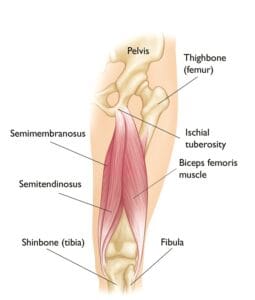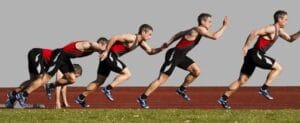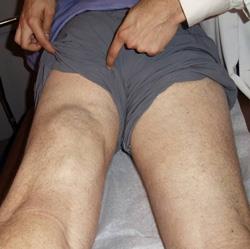Hamstring injuries, commonly referred to as “pulled hamstrings,” are a frequent concern among athletes, particularly those involved in high-intensity sports like track and field, soccer, and basketball that demand rapid sprinting. This type of injury involves damage to one or more muscles located at the back of the thigh. Fortunately, the majority of hamstring injuries can be effectively managed through straightforward, nonsurgical treatments.
Anatomy
The hamstring muscles are a group of three muscles that run along the back of the thigh: the semitendinosus, semimembranosus, and biceps femoris. These muscles originate from the ischial tuberosity, a bony prominence at the base of the pelvis, and extend downward to cross the knee joint, attaching to the lower leg. Near their attachment points, the muscle fibers integrate with strong connective tissues known as hamstring tendons.
The primary functions of the hamstring muscles include extending the leg backward and bending the knee, making them essential for various physical activities, including running, jumping, and walking.
Normal hamstring anatomy. The three hamstring muscles start at the bottom of the pelvis and end near the top of the lower leg.
Description
Hamstring strains can range in severity, involving a stretch, partial tear, or complete tear of the muscle. These injuries are classified into grades based on their seriousness:
- Grade 1: A mild strain that typically heals quickly.
- Grade 3: A severe injury involving a complete muscle tear, which may require several months to recover fully.
Most hamstring injuries occur in the thick, central portion of the muscle, known as the muscle belly, or at the junction where the muscle fibers transition into tendon fibers.
In extreme cases, the hamstring tendon may completely detach from the bone, sometimes pulling a fragment of bone along with it. This severe type of injury is referred to as an avulsion injury and often requires more intensive treatment.
A severe hamstring injury where the tendon has been torn from the bone.
Cause: Muscle Overload
Muscle overload is the primary cause of hamstring strains, occurring when the muscle is overstretched or subjected to a sudden, intense force.
Hamstring strains frequently happen during an eccentric contraction, a process where the muscle lengthens while contracting under load. This seemingly paradoxical action occurs when a muscle is both stretched and required to bear weight or force simultaneously.
For example, during sprinting, the hamstring muscles undergo eccentric contraction as the back leg straightens and the toes push off to propel the body forward. At this critical moment, the hamstrings are simultaneously lengthened and heavily loaded with the forces generated by body weight and forward motion, making them particularly susceptible to strain.
In addition to strains, severe injuries like hamstring tendon avulsions can occur when the muscle or tendon is exposed to a sudden, substantial load, further demonstrating the importance of proper conditioning and technique to prevent such injuries.
Risk Factors
Several factors can increase the likelihood of developing a hamstring strain, including:
- Muscle Tightness: Tight muscles are more prone to injury. Engaging in a consistent, year-round stretching routine can help maintain flexibility and reduce the risk of strains.
- Muscle Imbalance: When opposing muscle groups, such as the hamstrings and quadriceps, are uneven in strength, the weaker group is more susceptible to strain. This imbalance is common, as the quadriceps at the front of the thigh are typically stronger than the hamstrings. During high-intensity activities, such as sprinting, hamstrings may fatigue faster, increasing the risk of strain.
- Poor Conditioning: Weak or underdeveloped muscles are less equipped to handle the stress of exercise, making them more vulnerable to injury.
- Muscle Fatigue: Fatigued muscles lose their ability to absorb energy effectively, heightening the likelihood of strain.
- Activity Type: Certain activities and sports place individuals at greater risk for hamstring strains. These include:
- Football, soccer, and basketball
- Sprinting or running
- Dancing
- Activities involving older athletes primarily walking
- Adolescent athletes undergoing growth spurts
Hamstring strains are particularly common in adolescents due to the different growth rates of bones and muscles. During a growth spurt, bones grow faster than muscles, creating tension. A sudden movement, such as a jump or impact, can cause the muscle to tear from its connection to the bone.
Symptoms
A hamstring strain during high-speed activities, like sprinting, often results in a sudden, sharp pain in the back of the thigh, causing an immediate halt. You may either hop on your unaffected leg or fall.
Other common symptoms include:
- Swelling within the first few hours of injury.
- Bruising or discoloration on the back of the leg, often appearing below the knee, which can develop over a few days.
- Weakness in the hamstring, which may persist for several weeks, impacting mobility and strength.
Recognizing these symptoms early and seeking appropriate treatment is critical for a successful recovery
Imaging Tests
To accurately diagnose a hamstring injury, your doctor may recommend the following imaging tests:
- X-rays: These can reveal a hamstring tendon avulsion, where the injured tendon pulls away a small piece of bone.
- Magnetic Resonance Imaging (MRI): This imaging technique provides detailed visuals of soft tissues, such as the hamstring muscles, and helps determine the severity of the injury.
Treatment
The treatment approach for hamstring strains depends on the injury type, its severity, and your personal needs. The goal is to enable a full recovery, allowing you to resume your favorite activities while minimizing the risk of future injuries.
Nonsurgical Treatment
Most hamstring strains respond well to nonsurgical interventions, including:
- RICE Protocol:
- Rest: Avoid activities that caused the injury. Crutches may be recommended to reduce weight-bearing on the leg.
- Ice: Apply cold packs for 20 minutes several times a day, but never directly on the skin.
- Compression: Use an elastic bandage to reduce swelling and prevent further damage.
- Elevation: Keep your leg elevated above heart level to manage swelling.
- Immobilization:
A knee splint may be used temporarily to keep your leg in a neutral position for healing. - Physical Therapy:
Once initial pain and swelling subside, therapy begins with gentle stretching to improve flexibility. Strengthening exercises are gradually introduced, focusing on restoring range of motion and muscle strength. Your doctor will guide you on when it’s safe to return to sports activities.
Surgical Treatment
Surgery is typically reserved for severe injuries, such as tendon avulsions, where the tendon completely detaches from the bone.
- Procedure: The surgeon reattaches the tendon to the bone using small anchors after removing scar tissue.
- Rehabilitation: Post-surgery recovery involves avoiding weight-bearing activities, using crutches, and possibly wearing a brace to keep the hamstring relaxed. Rehabilitation includes progressive stretching and strengthening exercises.
- Proximal tendon reattachments: Recovery may take at least six months.
- Distal tendon reattachments: Recovery usually takes around three months before returning to sports.
Recovery
With proper treatment, most people regain full hamstring function. Early intervention using the RICE protocol combined with physical therapy improves outcomes and accelerates recovery. To prevent re-injury, it’s crucial to follow your doctor’s instructions and wait for their clearance before resuming sports. Reinjury can lead to chronic conditions and permanent damage.
New Developments
Recent studies are exploring the use of Platelet-Rich Plasma (PRP) therapy to enhance the healing of hamstring injuries. PRP, derived from the patient’s own blood, is rich in growth factors essential for tissue repair.
While some treatment centers are incorporating PRP injections into nonsurgical regimens, further research is needed to establish its effectiveness in speeding recovery and improving outcomes.









